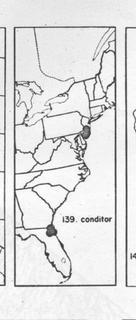
Arnold S. E. Menke, 1965 · 1
Ammophila conditor, map |
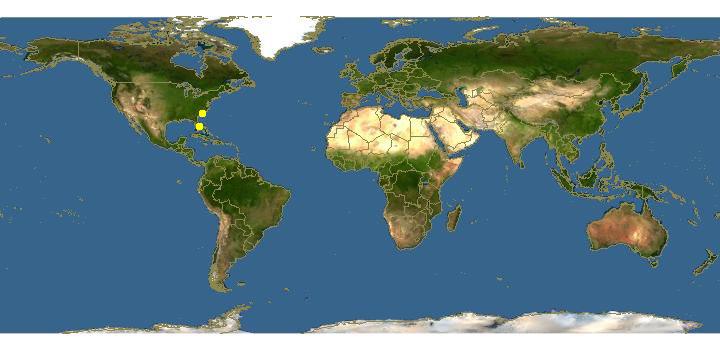
Click on map for details about points.
|
80x5 -
240x3 -
240x4 -
320x1 -
320x2 -
320x3 -
640x1 -
640x2
Set display option above.
Click on
images to enlarge. |
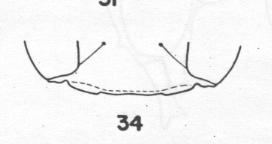
Arnold S. E. Menke, 1965 · 1
Ammophila conditor, clypeus |
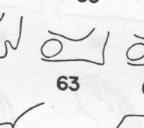
Arnold S. E. Menke, 1965 · 1
Ammophila conditor, metapleural flange |
|
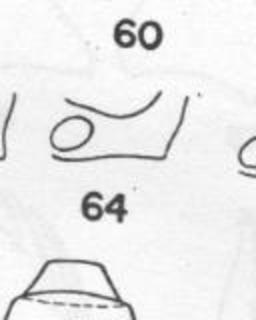
Arnold S. E. Menke, 1965 · 1
Ammophila conditor, metapleural flange |
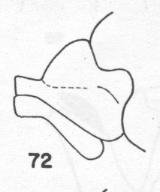
Arnold S. E. Menke, 1965 · 1
Ammophila conditor, A. ferruginosa, collar |
|
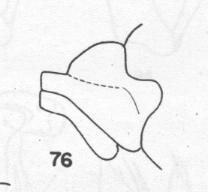
Arnold S. E. Menke, 1965 · 1
Ammophila conditor, A. boharti, collar |
|
Overview |
Taken from: A Revision of the North American Ammophila (hymenoptera, Sphecidae). Arnold S. E. Menke, 1965.
Ammophila (Ammophila) conditor Smith
(Figs. 34, 63-64, 139)
Ammophila conditor Smith, 1856. Cat. Hymen. Insect. Coll. Brit. Mus. 4:223.
Holotype female, “St. John’s Bluff”, E. Florida (British Museum, London).
Male. Average length 15 mm., range: 15-16 m.
Color. Black; petiole tergite red laterally, black above; gastral segment I red; wings clear, veins black.
Vestiture. Gena and pronotal side without appressed silver hair; mesopleuron with a band of appressed silver hair along mesopleural suture from base of midcoxa to bottom of hypoepimeral area; inferior metapleural area near hind coxa with an indistinct patch of appressed silver hair.
Structure. Flagellomere I longer than II (40:29), length less than least interocular distance (40: 54); collar similar to figure 68, ridges not reaching lateral line, interspaces moderately macropunctate, especially laterally, pronotal side moderately macropunctate with a few feeble ridges; scutum ridged, interspaces macropunctate; mesopleuron moderately to densely macropunctate, interspaces minutely etched; inferior metapleural area moderately macropunctate anteriorly, densely so posteriorly; propodeal side moderately macropunctate, interspaces irregularly rugose; metapleural flange lamellate, outer margin angulate (figs. 63-64).
Female. Average length 18 mm ., range: 18-19 mm.
Color. As in male except tegula and metapleural flange brownish; petiole tergite red.
Vestiture. Facial appressed hair sparse.
Structure. Clypeal disk slightly bulging near free margin, sparsely to moderately macropunctate, median free margin not produced, teeth absent, lateral free margin broadly lamellate (fig. 31); flagellomere I longer than II (51:31); inner orbits slightly converging below; collar similar to ferruginosa and boharti (figs. 72, 76), ridges mostly fine, inter- spaces sparsely macropunctate, pronotal side sparsely punctate; scutum smooth, moderately macropunctate, becoming punctatostriate towards scutal furrows, or scutum entirely ridged and punctate.
Range (fig. 139). A. conditor is poorly known. Only seven specimens have been seen and they are from New Jersey and Florida.
Material examined. (May to July) FLORIDA, 9 Co.: Gold Head Branch State Park (KVK). Duval Co.: Jacksonville (USNM). St. John’s Co.?: St. John’s Bluff (BMNH). NEW JERSEY, Atlantic Co.: Weymouth (UCD). Burlington Co.: Browns Mills (UCD). Cumberland Co.: Manumuskin (CUI).
Variation. None observed.
Systematics. The largely black body, angulate metapleural flange and lack of appressed silver hair on the gena and pronotal side are distinctive features of conditor. The only species occurring within the range of conditor that might be confused with it is A. procera which is much larger and does not have an angulate metapleural flange.
Fernald (1934) incorrectly synonymized conditor with procera. I have studied Smith’s type.
|
|
|
Names | |
|
|
| Supported by | |
Updated: 2024-04-25 06:42:59 gmt
|